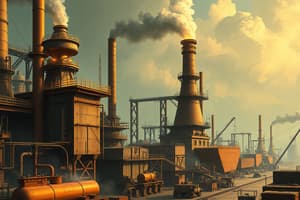Podcast
Questions and Answers
What is the Bessemer Process?
What is the Bessemer Process?
A process by which Andrew Carnegie made steel stronger and cheaper; allowed for massive industrial growth of the U.S.
Give an example of the Bessemer Process.
Give an example of the Bessemer Process.
Sir Henry Bessemer converted molten pig iron into strong steel by blowing a blast of oxygen through it.
What is a positive effect of the Bessemer Process?
What is a positive effect of the Bessemer Process?
It drastically cut steel prices in half, allowing widespread use, leading to more railroads and job opportunities.
What is a negative effect of the Bessemer Process?
What is a negative effect of the Bessemer Process?
Flashcards are hidden until you start studying
Study Notes
Bessemer Process Overview
- Developed by Sir Henry Bessemer to convert molten pig iron into stronger steel.
- Involved blowing oxygen through molten iron to reduce carbon content and eliminate impurities.
- Key driver of industrial growth in the United States, particularly in steel production.
Positive Effects
- Drastically reduced steel prices, making it widely accessible.
- Enabled large-scale construction of railroads and infrastructure, enhancing safety by using steel over iron.
- Increased job opportunities in steel manufacturing, contributing to economic expansion.
Negative Effects
- Often produced brittle and weak steel, leading to structural failures.
- Theories suggest that poor-quality steel may have contributed to the Titanic's sinking.
- Resulted in significant air pollution due to industrial emissions associated with steel production.
Studying That Suits You
Use AI to generate personalized quizzes and flashcards to suit your learning preferences.




